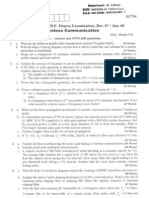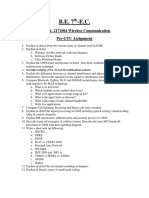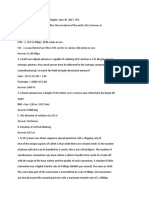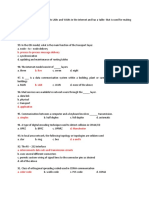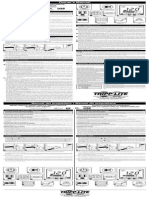0 ratings0% found this document useful (0 votes)
10 viewsOptical and wireless comm - Assignment 2
The document consists of a series of assignments related to Optical and Wireless Communication, specifically focusing on calculations involving mobile communication parameters such as Doppler frequency shifts, signal fading, and system capacity. It includes problems on frequency calculations for moving mobile subscribers, the impact of fading on signal quality, and the design of cellular systems with various configurations. The assignments require applying theoretical concepts to practical scenarios in mobile communication engineering.
Uploaded by
harshithgowdah88Copyright
© © All Rights Reserved
Available Formats
Download as DOCX, PDF, TXT or read online on Scribd
0 ratings0% found this document useful (0 votes)
10 viewsOptical and wireless comm - Assignment 2
The document consists of a series of assignments related to Optical and Wireless Communication, specifically focusing on calculations involving mobile communication parameters such as Doppler frequency shifts, signal fading, and system capacity. It includes problems on frequency calculations for moving mobile subscribers, the impact of fading on signal quality, and the design of cellular systems with various configurations. The assignments require applying theoretical concepts to practical scenarios in mobile communication engineering.
Uploaded by
harshithgowdah88Copyright
© © All Rights Reserved
Available Formats
Download as DOCX, PDF, TXT or read online on Scribd
You are on page 1/ 2
HKBK College of Engineering
Department of Electronics and Communication Engineering
Subject-Optical and Wireless Communication (21EC72)
Assignment-2
Q.1 A mobile subscriber travels at a uniform speed of 60 km/h. Compute the time between
fades if the mobile uses (a) a cellphone ope rating at 900 MHz (b) a PCS phone operating at
1900 MHz
Q.2 Consider a base-station transmitter operating at 900 MHz carrier frequency. For a mobile
moving at a speed of 72 km/h, calculate the received carrier frequency if the mobile is
moving (a) directly away from the base-station transmitter (b) directly towards the base-
station transmitter (c) in a direction which is 60 degrees to the direction of arrival of the
transmitted signal (d) in a direction perpendicular to the direction of arrival of the transmitted
signal.
Q.3 Determine the maximum speed of a vehicle in a mobile communication system
experiencing a maximum Doppler frequency shift of 70 Hz and a frequency of transmission
900 MHz.
Q.4 A mobile receiver is tuned to a transmission at 800 MHz and receives signals with
Doppler frequencies ranging from 10 Hz to 50 Hz when moving at a uniform speed of 80
km/h. What is the beamwidth of the mobile antenna?
Q.5 Consider a Rayleigh fading signal experiencing a maximum Doppler frequency of 20 Hz.
The carrier frequency is 900 MHz. Compute (a) the positive-going level-crossing rate for ρ =
1 (b) maximum velocity of the mobile for the given Doppler frequency.
Q.6 Assume that a bit error occurs whenever any portion of a bit encounters a fade for which
ρ < 0.1. For a given maximum Doppler frequency of 20 Hz, (a) What is the average fade
duration for threshold levels ρ = 0.01, ρ = 0.1, ρ = 0.707, and ρ = 1? (b) For a binary digital
modulation with a data rate of 50 bps, is the Rayleigh fading slow or fast corresponding to ρ
= 0.707? (c) What is the average number of bit errors per second for the given data rate of 50
bps?
Q.7 Consider that a mobile subscriber traveling at a uniform velocity of 96 kmph receive
digital data from a wireless communication system operating at 900 MHz carrier frequency.
What should be the symbol rate so as to receive distortionless transmission?
Q.8 What does a small delay spread indicate about the characteristics of a fading channel? If
the delay spread is 1 microsecond, will the two different frequencies that are 1 MHz apart,
experience correlated fading?
Q.9 Calculate the number of times the cluster of size 4 have to be replicated in order to
approximately cover the entire service area of 1765 km2 with the adequate number of
uniform-sized cells of 7 km2 each.
Q.10 (a) Assume a cellular system of 32 cells with a cell radius of 1.6 km, a total spectrum
allocation that supports 336 traffic channels, and a reuse pattern of 7. Calculate the total
service area covered with this configuration, the number of channels per cell, and a total
system capacity. Assume regular hexagonal cellular topology. (b) Let the cell size be reduced
to the extent that the same area as covered in Part (a) with 128 cells. Find the radius of the
new cell, and new system capacity.
Q.11 A mobile communication system is allocated RF spectrum of 25 MHz and uses RF
channel bandwidth of 25 kHz so that a total number of 1000 voice channels can be supported
in the system. (a) If the service area is divided into 20 cells with a frequency reuse factor of 4,
compute the system capacity. (b) The cell size is reduced to the extent that the service area is
now covered with 100 cells. Compute the system capacity while keeping the frequency reuse
factor as 4. (c) Consider the cell size is further reduced so that the same service area is now
covered with 700 cells with the frequency reuse factor of 7. Compute the system capacity.
Q.12 Consider that a geographical service area of a cellular system is 4200 km2 . A total of
1001 radio channels are available for handling traffic. Suppose the area of a cell is 12 km2 .
(a) How many times would the cluster of size 7 have to be replicated in order to cover the
entire service area? Calculate the number of channels per cell and the system capacity. (b) If
the cluster size is decreased from 7 to 4, then does it result into increase in system capacity?
Q.13 A cellular communication service area is covered with 12 clusters having 7 cells in each
cluster and 16 channels assigned in each cell. Show that (a) the number of channels per
cluster are 112 (b) the system capacity is 1344.
Q.14 Determine the number of cells in clusters for the following values of the shift
parameters i and j in a regular hexagonal geometry pattern: (a) i = 2 and j = 4 (b) i = 3 and
j = 3.
Q.15 Determine the distance from the nearest cochannel cell for a cell having a radius of 0.64
km and a cochannel reuse factor of 12.
Q.16 Determine the frequency reuse ratio for a cell radius of 0.8 km separated from the
nearest cochannel cell by a distance of 6.4 km.
You might also like
- Exercise 1 - Fundamental of Mobile NetworksNo ratings yetExercise 1 - Fundamental of Mobile Networks4 pages
- Wireless Communication ETEC 405 Assignment 1 CSE 2020No ratings yetWireless Communication ETEC 405 Assignment 1 CSE 20201 page
- Music Theory - Basic, Intermediate, Advanced PDF50% (10)Music Theory - Basic, Intermediate, Advanced PDF80 pages
- Answer Any Fivefull Questions.: Lo, G 0dband F 900 MHZ, FindpNo ratings yetAnswer Any Fivefull Questions.: Lo, G 0dband F 900 MHZ, Findp2 pages
- BECE307L-Wireless and Mobile Communication Digital AssignmentNo ratings yetBECE307L-Wireless and Mobile Communication Digital Assignment2 pages
- Siddaganga Institute of Technology, Tumakuru - 572 103: Usn 1 S I 7EC04No ratings yetSiddaganga Institute of Technology, Tumakuru - 572 103: Usn 1 S I 7EC042 pages
- 14EC2044 - Fundamentals of Wireless Communication - Question BankNo ratings yet14EC2044 - Fundamentals of Wireless Communication - Question Bank7 pages
- Wireless and Mobile Communications Mid Term Question Paper AK100% (1)Wireless and Mobile Communications Mid Term Question Paper AK10 pages
- Chipless Radio Frequency Identification Reader Signal ProcessingFrom EverandChipless Radio Frequency Identification Reader Signal ProcessingNo ratings yet
- Radio Propagation and Adaptive Antennas for Wireless Communication Networks: Terrestrial, Atmospheric, and IonosphericFrom EverandRadio Propagation and Adaptive Antennas for Wireless Communication Networks: Terrestrial, Atmospheric, and IonosphericNo ratings yet
- Transitions from Digital Communications to Quantum Communications: Concepts and ProspectsFrom EverandTransitions from Digital Communications to Quantum Communications: Concepts and ProspectsNo ratings yet
- Trường Thpt Chuyên Lê Quý Đôn Đề Kiểm Tra Giữa Học Kỳ 1 Môn: Tiếng Anh 12No ratings yetTrường Thpt Chuyên Lê Quý Đôn Đề Kiểm Tra Giữa Học Kỳ 1 Môn: Tiếng Anh 126 pages
- Study Manual For Amateur Station Operator's Licence Examination IndiaNo ratings yetStudy Manual For Amateur Station Operator's Licence Examination India200 pages
- LESSON II. Classification of Art: I. ObjectivesNo ratings yetLESSON II. Classification of Art: I. Objectives6 pages
- English Pedagogical Module 1: Free Time ActivitiesNo ratings yetEnglish Pedagogical Module 1: Free Time Activities32 pages
- And Spacing. Broad-Side Array. End-Fire Array. Phased Array.)No ratings yetAnd Spacing. Broad-Side Array. End-Fire Array. Phased Array.)21 pages
- Holy Spirit Come - (G, 93 BPM, 4/4) : (Default Arrangement) by Lane Oliver, Chris DavisNo ratings yetHoly Spirit Come - (G, 93 BPM, 4/4) : (Default Arrangement) by Lane Oliver, Chris Davis2 pages
- De Thi Chon HSG 2018 - 2019 - Tieng Anh d512398331No ratings yetDe Thi Chon HSG 2018 - 2019 - Tieng Anh d51239833111 pages
- Recommendation- Olympic Song - 北京欢迎你 - Welcome to Beijing100% (1)Recommendation- Olympic Song - 北京欢迎你 - Welcome to Beijing2 pages
- Edinburgh Fringe 2013 Programme Copy Form: Becomes Compromised? Canada'sNo ratings yetEdinburgh Fringe 2013 Programme Copy Form: Becomes Compromised? Canada's3 pages
- Fundamentals of Electronics Communications SystemsNo ratings yetFundamentals of Electronics Communications Systems32 pages
- King John (Play) : From Wikipedia, The Free EncyclopediaNo ratings yetKing John (Play) : From Wikipedia, The Free Encyclopedia6 pages










